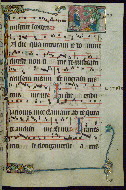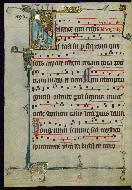Home > Digitized Walters Manuscripts
This document is a tranformation of a TEI P5 XML manuscript description incorporating images. If you have trouble reading special or non-Latin characters on this page, please make sure you have appropriate Unicode fonts installed and an up-to-date web browser.
Walters Ms. W.761, Beaupre Antiphonary, Vol. 3
Browse images (Browse images in a new window) | TEI in XML format
W.761
Beaupre Antiphonary, Vol. 3
Illuminated in Hainaut ca. 1280 and completed in 1290, this collection of richly illuminated Cistercian manuscripts is a rare example of those being produced in Flanders at the end of the thirteenth century. Nineteen extant large historiated initials, flourished and decorated initials, and an abundance of amusing drolleries facilitate a liturgical narrative within the text. However, additions and removals within the text and imagery tells much about the use and history of the manuscript. This manuscript is the third volume of the three-volume set (volumes one and two are lost) destined for the prioress at the Cistercian abbey of Sainte-Marie at Beaupré (diocese of Cambrai). The liturgical contents of this volume provide musical settings from Christmas to Easter. Two sets of antiphonaries, each composed of three volumes, were originally created for the abbess and prioress of Beaupre. Of these two sets, the Walters Art Museum houses three volumes: two volumes from the set intended for the abbess and one volume from the set designated for the prioress. A fourth associated volume was created later to supplement W.759. It should be noted that apart from the volumes housed at the Walters, there survive four cutout initials from the other volumes. However, in 1865, these manuscripts were regrettably lost in a fire that spread from a house adjacent to Sotheby’s, where the books were being prepared for sale. In addition to the manuscripts' rich illumination, there is also a wealth of historical evidence throughout. Added at the beginning of each volume is a full-page inscription that details ownership. In the third volume it reads, “Antiphonaire pour sevir dans le Coeur du coté de Ma-Dame L’abbesse, depuis, le Nöel iusqu' à paques.” Further information on provenance can be gleaned from the illumination itself; this volume contains an author portrait of the scribe/artist, a Cistercian monk named Johannes de Toussens (fol. 1r); while the manuscripts' patroness who married into the de Viane family is depicted with a younger woman named Clementia on fol. 3v of vol. 1 (W.759). Donations by members of the de Viane family to Sainte-Marie of Beaupré were recorded from 1244 to 1293. Since the volume’s assemblage, there have been updates in two major campaigns: ca. 1475-1500 at which time select thirteenth-century Offices were replaced in part by revisions and by additions placed at the end of the volume (see W.762 for supplement) and the second campaign in the eighteenth century at which time some thirteenth and fifteenth-century leaves were removed, changes were made to both neumes and text passim, and additions were added at the end of the volume or in the Supplement. The first of these campaigns was presumably for abbess Jacqueline Hendricx (1473-1500), the second in the eighteenth century likely for the last abbess, Angéline de Lossy (1755-96), after which point the abbey was seized during the French Revolution. Drolleries are most often found on pages with historiated initials, and principally focused on centered bas-de-page scenes. While many drolleries were effaced, some traces of these images can be recognized by their shadowy outlines. Many of these erasures are thought to be at the hand of John Ruskin, who is also credited with authoring a separate table of contents, as well as several transcriptions of the Latin text found on numerous leaves. Truly a remarkable work, this multi-volume antiphonary was generously gifted to The Walters Art Museum in 1957 at the bequest of the Hearst Foundation.
Dated 1290 CE
Hainaut
Book
Liturgical
The primary language in this manuscript is Latin. The secondary language of this manuscript is French, Middle (ca.1400-1600).
Parchment
Parchment medium to heavy in weight, well selected and prepared; lower edges are grimed by use, although the edges are in better condition, with fewer mends as well, than in the abbess' volumes (W.759 and W.760); front flyleaves and back flyleaves are of modern parchment, after 1904; added title page; modern table of contents laid in; cropped close to decoration
Foliation: iii+title page+270+iii
Three foliation programs: the first in the style of fifteenth-sixteenth century with roman numerals at or near center fore-edge on rectos, in dark brown ink, two sequences, the first "i"-_cclxv" (now fols. 1-225, xli inadvertently repeated on fols. 34, 35); a second sequence for Common of Saints that lacks opening leaf, therefore reads "ii"-"lii" (now fols. 226-267), no foliation on last three extant leaves (fols. 268-270); second sequence in the style of eighteenth-nineteenth century with Arabic numerals after the first, "i"-"597/598" beginning on present fol. 1, in top outer corner of each recto/verso, in dark brown ink; the third sequence dates after 1957, the most recent foliation sequences, fols. 1-270, in pencil at top right of each rectos (used here)
Formula: Quire 1: 10, with folio before fol. 1 cancelled; tipped in singletons: unnumbered title page, 2, 5 (fols. 1-9); Quire 2: 8 (fols. 10-17); Quire 3: 8, with fifth to eighth folios cancelled after fol. 20 (fols. 18-21); Quire 4: 8, with first, second, and third folios cancelled (fols. 22-26); Quire 5: 8 (fols. 27-34); Quire 6: 8 (fols. 35-42); Quire 7: 8, with first and third folios cancelled (fols. 43-48); Quire 8: 8, with third, fourth, fifth, seventh, and eighth folios cancelled (fols. 49-51); Quire 9: 8, with first and third folios cancelled (fols. 52-57); Quire 10: 8, with third folio cancelled (fols. 58-64); Quire 11: 8, with third folio cancelled (fols. 65-71); Quire 12: 8, with first and sixth folios cancelled (fols. 72-77); Quire 13: 8, with eighth folio cancelled (fols. 78-84); Quire 14: 8 (fols. 85-92); Quire 15: 8, with second folio cancelled (fols. 93-99); Quire 16: 8, with first, fifth, and sixth folios cancelled (fols. 100-104); Quire 17: 8, with sixth folio cancelled (fols. 105-111); Quire 18: 8, with seventh folio cancelled, first folio tipped in after fol. 111 (fols. 112-118); Quire 19: 8, with third and fourth folios cancelled (fols. 119-124); Quire of 10 missing; Quire 20: 8 (fols. 125-132); Quire 21: 8, with first folio tipped in after fol. 132 (fols. 133-140); Quire 22: 8 (fols. 141-148); Quire 23: 8, with first folio tipped in after fol. 148 (fols. 149-156); Quire 24: 8 (fols. 157-164); Quire 25: 8 (fols. 165-172); Quire 26: 8 (fols. 173-180); Quire 27: 8, with sixth folio tipped in after fol. 185 (fols. 181-188); Quire 28: 8 (fols. 189-196); Quire 29: 8 (fols. 197-204); Quire 30: 8 (fols. 205-213); Quire 31: 8 (fols. 213-220); Quire 32: 8, with fourth, sixth, and eighth folios cancelled (fols. 221-225); Quire 33: 8 (fols. 226-233); Quire 34: 8, with fourth folios cancelled (fols. 234-240); Quire 35: 8, with second and sixth folios cancelled (fols. 241-246); Quire 36: 8, composite: sewing between second and third folios, fols. 248-249 (fols. 254); Quire 37: 8, with fifth folio cancelled (fols. 255-261); Quire 38: 8, with sixth, seventh, and eighth folios cancelled (fols. 262-266); Quire 39: 8, with first, second, third, and fourth folios cancelled (fols. 267-270)
Comments:
30.1 cm wide by 42.2 cm high
21.1 cm wide by 31.6 cm high
- Columns: 1
- Ruled for plainsong notation, eight 4-lined staves alternating with one line of text; ruled in lead, horizontals bounding first and last lines of text, additional ruling above first stave, paired outer verticals to edges; pricklings visible mostly at top and bottom margins, rarely visible at fore-edge
- Title: Antiphonary, Vol. 3 of 3-vol. set for prioress of Sainte-Marie of Beaupré: Christmas to Easter
- Hand note: Written in textura formata; musical notation in plainsong style, square notation on four-lined staves; fols. 43r-62v: eighteenth-century addition written in regularly formed roman script
- Decoration note: Nineteen historiated initials, ranging in size from 1-5 lines of plainsong notatation + 1-5 lines on text; one miniature extant in volume; drolleries passim; musical notation in dark brown ink, staves in red; rubrics and headings in red; text in dark brown ink
- Title: Temporale, Nativity of Christ (Christmas Day) Vespers through Palm Sunday
- Incipit: Antequam convenirent inventa est Maria
- Contents: Fols. 1r-20v: Nativity, + octave; fols. 1-2v: Vespers antiphon, "Antequam convenirent inventa est Maria . . . ."; fol. 2r: cue to hymn "Intende" (cf. fol. 270v); fols. 2v-20v: Christmas Day: fols. 2v-3v: Matins invitatory, etc., fol. 4r: Matins, first responsory, "Hodie nobis celorum rex . . . . [fol. 10v, Canticles, fourth responsory] Verbum caro factum est . . . . [fol. 11v, Lauds antiphon] Genuit puerpera regem . . . . [fol. 14r, Magnificat antiphon] Hodie christus natus est . . . .", fol. 14v-20v: Private days until Epiphany (Jan. 6): fol. 15r, Matins, first responsory, "In principio erat verbum"; fol. 20v: Sunday in octave after Nativity, "Christus natus est nobis . . . ."; text gap after fol. 20: seven leaves (xxi-xxvii), containing end of preceding Office and part of Office of Circumcision; no gap in arabic foliation (as after fol. 124, 266); fols. 21r-27v: Circumcision (Jan. 1), preliminary texts, feast, Commemorations, beginning imperfectly, "factum sub lege . . . . R. Verbum caro factum est . . . ."; fols. 27v-52v: Epiphany (Jan. 6), vigils, feast, octave (Jan. 13), through Sunday IV, after octave, lacunae; fol. 27v (cues for vigils Vespers antiphon on psalms, responsory, etc.): In principio. R. Illuminare . . . . [fol. 28r, Vigils, Magnificat antiphon] Magi viderunt stellam . . . . [fol. 29v, Matins, first responsory] Hodie in iordane baptizato . . . . [fol. 36v, second nocturn, first responsory] In columbe specie . . . . [fol. 37v, Lauds antiphon] Ante luciferum . . . . [fol. 37v, Benedictus antiphon] Hodie celesti . . . . [fol. 42v, Epiphany octave, Magnificat antiphon] Baptizat miles regem. Servus dominum suum. Iohannes Saluatorem . . . ." [letters one, two, nine, ten, thirteen in last two words embellished with red and reserved flowers, letters three-eight stroked in red; floral embellishment applied passim in rest of antiphon]; text gap after fol. 42: one leaf (xlix, 85/86); Epiphany octave continues; fol. 43r: “dei verticem. sed clamat . . . . V. Omnis terra. Ad. vi. a. Caput draconis saluator . . . . [fol. 44v, first nocturn, vericle, end imperfectly] Memor fui . . . / . . . Et cus. le. t.”; text gap after fol. 44, one leaf (lii, 91/92); fol. 45r-50v: Epiphany, Saturday after octave through most of Sunday IV, fol. 50v: Sunday IV, Benedictus antiphon; text gap after fol. 50 (lix-lxi, 105/106-109/110): three leaves, the first identifiable as BBR IV 548, contains flourished “B” (1 line of plainsong notation + 1 line of text); numbered 105/106, purchased from Maggs Bros,, 1969; previously sold in London, Sotheby’s, Dec. 11, 1968, lot 170 (cf. below, text gap after col. 223; see Cinq annés 1975, no. 7; Glorieux 1979, no. 39; Manuscrits à painters, no. 22; Manuscrits cisterciaens 1990, no. 52); fols. 51r-v: Epiphany Sunday IV continued beginning and ending imperfectly, “auxiaretur cor meum . . . . R. Deus in speravi . . . / . . . [versicle] Gaudebunt labia”; text gap after fol. 51 (lxii-lxv, 113/114-117/118): three leaves, the first two completing preceding Office extant in Bloomington, Indiana University, Lily Library: Ricketts mss. 79 (shelfmarkcourtesy of Rebecca Campbell Cape), numbered 113/114, 115/116. Acquired 1961 (Faye and Bond, pg. 539), ex-coll. C. L. Ricketts; his purchase from bookseller James Trevaskis, London, 1922 (background information on Trevaskis kindly suppled by Roland Folter and Kimball Higgs) Bib. refs.: de Ricci, vol. 1, pg. 629; Cinq annés, pg. 15; for other leaves in same group at the Lily Library of Indiana University, see citations under text gaps after fols. 99, 117, 120, 236, 258; fols. 52r-v: Epiphany, Sunday IV after octave to end, text begins imperfectly; fols. 52v-59v: Saturday in Septuagesima, incomplete (fol. 52v, cues to Vespers responsory and versicle, incomplete Magnificat antiphon); text gap after fol. 52: one leaf (lxviii, 121/122), preceding Office continued through Benedictus antiphon, text begins imperfectly; fol. 59v: Saturday in Sexagesima, cues for Vespers responsory, Magnificat antiphon, Invitatory, responsory; text gap after fol. 59: one leaf (lxxv, 137/138), rest of preceding Office lacking; fols. 60r-111r: Quinquagesima, begins imperfectly, includes serial and Sunday Offices in Lent; numerous lacunae as noted below, mostly single leaves, often containing beginning of Sunday Office; offsets of flourished borders (e.g. fols. 67r, 76r, 84v), probably issuing from flourished initial in _________ and extant in this Office on fol. 107v; fols.60r-66v: first sequence, begins imperfectly, "cham et clausit a foris . . . . V. Noe uero et filii eius . . . . (fol. 66v, Saturday, Vespers antiphon, versicle); text gap after fol. 71: one leaf (lxxxix, 165/166); fols. 72r-74v: Quinquagesima continues, "evovae. R. Participem me fac deus . . . . (fol. 75v: feria vi, Magnificat antiphon, heading for Saturday Benedictus antiphon) Domine non habeo hominem . . . Sabbato Ad Benedictus Antiphona"; text gap after fol. 75: one leaf (xciv, 175/176); fols. 76r-84v: Quinquagesima continues, "mei sicut odor agri . . . . V. Qui maledixerit tibi . . . . [fol. 84v, feria v, Benedictus antiphon] Operamini"; text gap after fol. 84: one leaf (civ, 195/196); fols. 85r-93v: Quinquagesima, continued, "venundetur. Et manus noe . . . . V. Quid nobis . . . . [fol. 93v, Saturday, Benedictus antiphon] Inclinavit se ihesus [red-stroked] scribebat in terra si quis sine pecca"; text gap after fol. 93: one leaf (cxiv, 215/216); fols. 94r-99v: Quinquagesima continues, "ti. V. Videns vidi afflictionem . . . . [99v, versicle] Popule meus quid feci . . . . / . . . michi quoniam"; text gap after fol 99v: one leaf (cxxi, 229/230), extant in Bloomington, Indiana University, Lilly Library (see text gap after fol. 51); fols. 100r-102v: Quinquagesima continues, "evovae. [Terce antiphon] De quinque panibus . . . [fol. 102v, Saturday Benedictus antiphon] Ego sum"; text gap after fol. 102: two leaves (cxxv, cxxvi; 237/238, 239/240); fols. 103r-109v: Quinquagesima continues, "custodiebant animam meam . . . . [fol. 109v, private days, invitatory] Adoremus dominum qui nos rede"; text gap after fol. 109: one leaf (cxxxiv, 255/256); fols. 110r-111r: Quinquagesima ends, end of feria iv through Saturday Benedictus antiphon, "nobis propter . . . . [fol. 110v-111r] Pater iuste mundus . . . ."; fols. 111r-124v: Palm Sunday, lacunae, fols. 111r-117v: first sequence; fol. 111r; (Vespers responsory), "Circumdederunt me viri . . . . [fol. 112r, Matins, first responsory] In die qua invocavi te domine . . . . [fol. 117v, responsory] Insurrexeretur in me . . . omnia ossa me a.e."; text gap after fol. 117: one leaf (cxliii, 273/274), extant in Bloomington, Indiana University, Lilly Library (see text gap after fol. 51); fols. 118r-120v: Palm Sunday continues, "varum obviaverunt . . . . [Terce, hymn cue] Iam surgit. [antiphon] Pueri hebreorum . . . . [fol. 120v, feria ii, versicle, ends imperfectly] Dixerunt impii . . . contrarius est operibus nos"; text gap after fol. 120: two leaves (cxlvii, cxlviii; 281/282, 283/284), first leaf extant in Bloomington, Indiana University, Lilly Library (see text gap after fol. 51); fols. 121r-124v: Holy Week, ends imperfectly in fourth ferial day with heading for None; fols. 121r-124v: "loquebamini mori pro me . . . . V. Dormite iam et requiescite . . . . [Sext antiphon, heading for None antiphon] Consilium fecerunt . . . Ad. ix. a."; text gap after fol. 124: ten leaves (cliii-clxii, no gap in arabic foliation as after fol. 20, 266)
- Text note: Text gaps throughout; some missing leaves accounted for, see text gap after fols. 51, 99, 117, and 120
- Decoration note: Fol. 1r: Cistercian scribe depicted in lower margin, center; historiated initials on fols. 1r, 4r, 11v, 28r, 29v; one panel miniature on fol. 112r
- Title: Sanctorale, St. Stephen (Dec. 26) through Annunciation (Mar. 25)
- Contents: Fols. 125r-270v: Sanctorale, St. Stephen (Dec. 26) through Annunciation (Mar. 25); fols. 125r-133r: St. Stephen (Dec. 26), and octave; fol. 125r: Vespers antiphon, "Stephanus autem plenus gratia . . . . [fol. 125v, Matins, first responsory] Hesterna die dominus natus . . . . [fol. 132, Commemoration of Nativity, cue] Genuit puerpera"; fols. 133r-141v: St. John the Evangelist (Dec. 27), and octave; fol. 133r: Vespers, Commemoration of Nativity, "Iste est Iohannes . . . ." Long marginal notation, ca. fifteenth century; fol. 133v: Commemoration of Nativity, cue, "Virgo hodie fidelis."; fol. 133v: Office of St. John Evangelist, Matins, first responsory, "Qui vicerit faciam . . . . [Commemoration of Nativity] Lux orta est . . . . [Feast, octave, Vespers antiphon] Iste est iohannes . . . ."; fols. 141v-149v: Holy Innocents (Dec. 28), and octave; fol. 141v: Vespers, Commemoration of Nativity, "O quam gloriosum est regnum . . . . [fol. 142r, Matins, first responsory] Sub altare dei . . . . [fol. 147v, Lauds antiphon] Herodes iratus . . . . [fol. 148r, Commemoration of Nativity, cue] Natus est nobis."; fol. 149v: cues to Commemoration of Nativity, and for Lauds/Vespers antiphons in octave of Holy Innocents, "Hodie intacta. [Lauds] Herodes iratus. [Vespers] Sinite parvulos . . . O quam gloria"; fol. 149v: St. Thomas of Canterbury (Dec. 29); cues for Lauds, Vespers antiphons, "Verbum caro . . . . Nesciens mater."; fols. 149v-160v: St. Agnes (Jan. 21); fol. 149v: cues, opening responsory, "Pulcra facie."; fol. 150r: Matins, first antiphon, "Descede a me . . . . [fol. 151r, Matins, first responsory] Diem festum sacratissime virginis"; fols. 160v-171v: Conversion of Paul (Jan. 25); fol. 160v: cues to Vespers responsory and hymn, full Magnificat antiphon, "Scio cui . . . . H. Eterna christi. Ad. m. a. Sancta paule ['a' and 'p' red-stroked and with reserved florets] apostoli predicator . . . . [first nocturn: Matins, first responsory] Qui operatus est petro . . . . [fol. 162v, Matins, first responsory] Qui operatus est petro . . . . [fol. 170r, Lauds antiphon] Ego plantavi . . . . [fols. 171v, 172r: Vespers antiphon cues] Qui operatus es . . . . In regeneratione cum sederit . . . ."; fol. 172r: St. Agnes, octave (Jan. 28), cues to Vespers and Lauds antiphons, "Stans beata Agnes." and "Beata Agnes"; fols. 172r-184r: Purification of the Virgin (Feb. 2), Vespers antiphon on psalms, "O ammirabile commertium . . . . [fol. 174v, first nocturn: Matins, first antiphon] Benedicta tu . . . . [fol. 175v, Matins, first responsory] Adorna thalamum tuum Syon . . . . [fol. 183r, Lauds, antiphon] Symeon iustus . . . ."; fols. 184v (heading), 185r-195r): St. Agatha (Feb. 5); fol. 185v: Vespers responsory cue, "Beata Agata."; fol. 186r: Matins, first responsory, "Agatha letissime et glorianter . . . ."; fol. 193v: Lauds antiphon, "Quis es tu . . . ."; fols. 195r (heading), 195v-205v: St. Peter's Chair (Feb. 22); fol. 195v: Vespers responsory cue, "In omne terra."; fol. 196v: Matins, responsory, "Quem dicunt homines . . . ."; fols. 205v-216v: St. Benedict (Mar. 21); fol. 205v: Vespers, cue to antiphon on psalms, "Benedictus."; fol. 207v: Matins, first responsory, "Fuit vir vite venerabilis . . . ."; fol. 213r: Lauds, antiphon, "Electus a fratribus . . . ."; fols. 216v-225v: Annunciation (Mar. 25); fol. 216v: Vespers antiphon, "Non auferetur sceptrum . . . ."; fol. 217v: first nocturn, Matins, first antiphon, "Missus est Gabriel . . . ."; fol. 218v: Matins, first responsory, "Missus est gabriel . . . ."; fol. 223v: responsory ends imperfectly, "Videbunt gentes . . . Et vocabitur tibi no"; text gap after fol. 223: one leaf (clxii, 491/492); extant as BBR IV 173: Glorieux 1979, no. 19; Manuscrits datés . . . en Belgique, vol. 1, no. 23, Pls. 75-76; other bibliographic references as for BBR IV 548, cited in part one: Temporale; fols. 224r-v: Annunciation continued, end imperfectly, "credimus impregna tu . . . . [Lauds antiphon] Beatam me dicent omnes . . . . [Terce antiphon] Ecce concipiens in utero et"; text gap after fol. 224: one leaf (cclxiv, 495/496); fols. 225r-270v: Common of Saints, lacunae as noted, second numbering sequence begins "ii" on fol. 226 (as in W. 760, fol. 195); Office of Apostles, beginning imperfectly, "columbe evovae. Invit. Gaudete et exultate . . . . [fol. 225v, cues for antiphon, psalm, versicle, ending imperfectly] Principes populum . . . . Omnes gentes. In om"; text gap after fol. 225: one leaf (i, 499/500); fol. 226r: Common of Saints, Office of Apostles continues, incomplete, "ante reges et presides . . . . V. Non enim vos estis . . . . R. O quam pulchri super montes . . . ."; fol. 235r: One martyr, Vespers responsory cue, "Gloria et honore."; fol. 235v: antiphon, "Iustus dominus et iusticias dilexit equitatem"; text gap after fol. 236: one leaf (xiii, 523/524); extant in Bloomington, Indiana University, Lilly Library; see text gap after fol. 52; fols. 237r-241v: Common of Saints, Office of martyr continues, incomplete, "tus est in numero sanctorum. V. Iste est qui contempsit; text gap after fol. 241: one leaf (xix, 535/536); fol. 242r: Common of Saints, Office of martyr concluded; fol 242r: Benedictus antiphon, "Qui vult venire . . . .; fols. 243v-244v: Office of Several martyrs, cue to Vespers responsory, "Lauerunt stolas . . . . [fol. 244v, fourth antiphon in Matins, ending imperfectly] Letentur omnes qui sperant in te domine quoniam tu b"; text gap after fol. 244: one leaf (xxiv, 543/544), text loss includes first responsory in Matins ("Absterget deus omnem lacrimam), perhaps illuminated, traces of effaced offset in upper margin; same text in identical context illuminated in W. 760, fol. 220; not illuminated in W. 759, fol. 202v; fols. 245-253: Common of Saints, Office of Several martyrs concluded; fol. 245r, "Quoniam. R. Viri sancti gloriosum . . . ."; fols. 253r-260v: confessor-pope, "Sint lumbi . . . ." [fol. 253v, Matins, first responsory] Euge serve bone et fidelis . . . . [fol. 255v, second nocturn, first responsory, cue] Domine iste sanctus."; fol. 258v: responsory, ending imperfectly, "Sint lumbi vestri . . . dominum suum quando reverta"; text gap after fol. 258: one leaf (xxxviii, 573/574), extant in Bloomington, Indiana University, Lilly Library; see text gap afer fol. 51; fols. 259r-260v: Common of Saints, Office of confessor-pope concluded; fol. 259r: "am suam. evovae. V. Iustum deduxit . . . ."; fols. 260v-266v: Confessor non-pope, beginning with cue to Vespers responsory, "Amavit eum dominus." (fol. 261r, Matins, first responsory), "Euge serve bone et fidelis . . . ."; fol. 266v: cues to Commemoration of St. John the Evangelist, Vespers and incomplete Matins antiphon, "Iste est Iohannes qui supra pectus domini . . . . Valde honorandus . . . supra pectus domini in cena"; text gap after fol. 266: four leaves (xlvii-li), no gap in arabic foliation (as affter fols. 20, 124); fols. 267r-v: Common of Saints, cues at end of Commemoration of Several martyrs, confessor-pope, confessor non-pope, several confessors; Commemoration of virgin saint at Vespers and Lauds, full texts instead of cues, "sancti qui per te. In laudibus co. Fulgebunt . . . . [Virgin, Vespers] Veni sponsa christi . . . . [Lauds] Veni electa . . . / . . . speciem tuam. evovae."; fols. 267v-268r: St. Scholastica, Commemoration at Vespers and Lauds, texts in full as on fols. 267r-v, "Quinque prudentes virgines . . . . Veniente sponso . . . / . . . ad nuptias. evovae; fols. 268r-270r: Hymn, "Te deum laudamus"; fol. 270v: Christmas Day, Vespers hymn, incomplete (lacks roman folio number 597/598), "Intende qui regis Israel . . . / . . . [text ends imperfectly in third verse] verbum dei factum est caro.", cf. cue to same hymn on fol. 2; leaf with flourished initials, perhaps belonging at end of original contexts of this volume containing the first to third tones of eight tones of the "Gloria," numbered 601/602; full text in W. 762, fols. 61r-62r; severely cropped to 39.6 x 30.4 cm: London, Sotheby's, Dec. 6, 1988, lot 5; to private collector, Belgium (information courtesy of Christopher de Hamel)
- Text note: A table of contents on rectos of two unnumbered modern parchment leaves (42.4 x 30.8cm), black on other side, loosely laid in at back; England, ca. second-half of twentieth century; probably authored by John Ruskin; in faded black ink, page references to arabic foliation on recto/verso; first leaf headed, "Vol. III," second leaf headed "Vol. IV," indicating division of this volume into two parts while owned by Ruskin; annotations show special interest in decorated gold initials and familiarity with medieval manuscripts, i.e. "small letter, fine of its kind," "the beautiful letter H," "common letter" (referencing here fols. 14r, 37v, 42v); note also "blunderingly altered," "the rubric at 80 is unusual," "Rubric, but common" (referencing fols. 36v, 40v, 149v);
- Decoration note: Historiated initials on fols. 125r, 133v, 142r, 151r, 162v, 175v, 186r, 196v, 207v, 253v, 268r, 270v
fol. 1r:
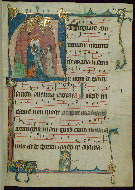
- Title: Initial "A" with Visitation, Cistercian nun in prayer; marginal author portrait of Cistercian monk Johannes de Toussens
- Form: Historiated initial "A," 4 lines plainsong notation + 4 lines text; marginal author portrait
- Text: Temporale: Nativity Vigils, Vespers antiphon
- Comment:
In bottom margin, monk Johannes holds scroll that reads "I, John, wrote this book."
fol. 4r:
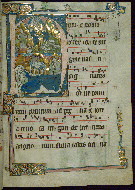
- Title: Historiated initial "H" with Nativity, Annunciation to Shepherds
- Form: Historiated initial "H," 5 lines plainsong notation + 5 lines text
- Text: Nativity Vigils, antiphon
fol. 11v:
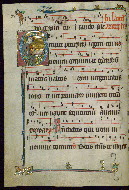
- Title: Initial "G" with Virgin rocking Christ in cradle
- Form: Historiated initial "G," 2 lines plainsong notation + 2 lines text
- Text: Nativity: Lauds antiphon
fol. 28r:
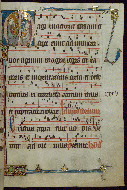
- Title: Initial "M" with Adoration of Magi
- Form: Historiated initial "M," 2 lines plainsong notation + 2 lines text
- Text: Epiphany Vigils: Vespers antiphon
fol. 29v:
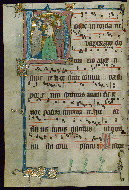
- Title: Initial "H" with Baptism of Christ as member of the Trinity
- Form: Historiated initial "H," 3 lines plainsong notation + 3 lines text
- Text: Epiphany: antiphon
fol. 112r:
fol. 125r:
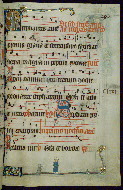
- Title: Initial "S" with St. Stephen revered by Cistercian nun
- Form: Historiated initial "S," 1 lines plainsong notation + 1 lines text
- Text: Sanctorale: St. Stephen, Vespers antiphon
fol. 125v:
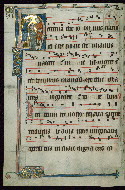
- Title: Initial "H" with Martyrdom of St. Stephen
- Form: Historiated initial "H," 2 lines plainsong notation, 2 lines text
- Text: Sanctorale: St. Stephen, antiphon
fol. 133v:
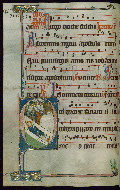
- Title: Initial "Q" with St. John the Evangelist lying in coffin, blessing five liars
- Form: Historiated initial "Q," 3 lines plainsong notation, 3 lines text
- Text: Sanctorale: St. John Evangelist, antiphon
fol. 142r:
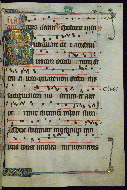
- Title: Initial "S" with Massacre of the Innocents
- Form: Historiated initial "S," 2 lines plainsong notation, 2 lines text
- Text: Sanctorale: Holy Innocents, antiphon
fol. 151r:
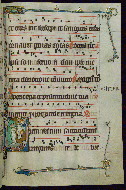
- Title: Initial "D" with St. Agnes brought robe by angel
- Form: Historiated initial "D," 2 lines plainsong notation, 2 lines text
- Text: Sanctorale: St. Agnes, antiphon
fol. 162v:
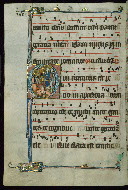
- Title: Initial "Q" with Conversion of Paul
- Form: Historiated initial "Q," 2 lines plainsong notation, 2 lines text
- Text: Sanctorale: St. Paul, antiphon
fol. 175v:
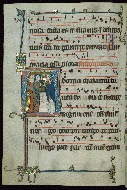
- Title: Initial "A" with Presentation in the Temple
- Form: Historiated initial "A," 3 lines plainsong notation, 3 lines text
- Text: Sanctorale: Purification of Virgin, antiphon
fol. 186r:
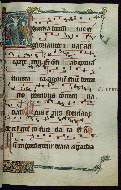
- Title: Initial "A" with Martyrdom of St. Agatha
- Form: Historiated initial "A," 2 lines plainsong notation, 2 lines text
- Text: Sanctorale: St. Agatha, antiphon
fol. 196v:
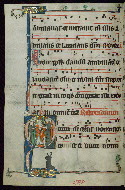
- Title: Initial "Q" with Peter enthroned
- Form: Historiated initial "Q," 2 lines plainsong notation + 2 lines text
- Text: Sanctorale: Chair of St. Peter, antiphon
fol. 207v:
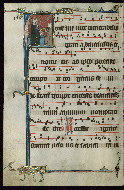
- Title: Initial "F" with Presentation of book to St. Benedict by kneeling Cistercian monk
- Form: Historiated initial "F," 2 lines plainsong notation + 2 lines text
- Text: Sanctorale: antiphon
fol. 218v:
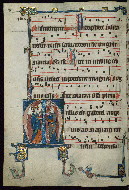
- Title: Initial "M" with Annunciation
- Form: Historiated initial "M," 3 lines plainsong notation + 3 lines text
- Text: Sanctorale: Annunciation, antiphon
fol. 253v:
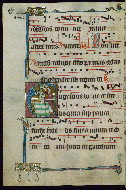
- Title: Initial "E" with Baptism of man in imperial crown, with God-head and dove
- Form: Historiated initial "E," 2 lines plainsong notation + 2 lines text
- Text: Sanctorale: Confessory-pope saint, antiphon
fol. 268r:
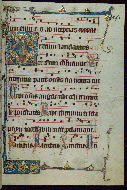
- Title: Initial "T" with Christ in Majesty
- Form: Historiated initial "T," 2 lines plainsong notation + 2 lines text
- Text: Sanctorale: antiphon
fol. 270v:
The binding is not original.
Late medieval binding possibly extant when acquired by John Ruskin, ca. 1850; rebound in England, after 1904; modern crimson velvet, worn; modern parchment pastedowns and endleaves; spine rounded and covered in red morocco; five compartments; gilt title "Antiphonarium Ecclesie S. Mariae de Bello Prato I MS. AD 1290"; edges are part gilt and partially painted blue; red drop-front box, curved red morocco spine compartmentalized and titled the same as volume
Created in Hainaut ca. 1290 by the Cistercian monk Johannes de Toussens (see author portrait on fol. 1r of vol. III, W.761) for the prioress of the Cistercian abbey of Sainte-Marie of Beaupré at Grimmage near Geerardsbergen (Grammont, diocese of Cambrai, later Malines)
Abbess Jacquemine Hendricx, after 1476, Cistercian abbey of Sainte-Marie of Beaupré at Grimmage; extensive revisions, first of two major campaigns, begun under her
Abbess Angéline de Lossy (1755-96), eighteenth century; second campaign of extensive revisions; abbey seized during French Revolution and subsequently sold in 1797; church destroyed soon thereafter
John Ruskin, London, ca. 1850; likely his erasures of marginalia and grotesques
Arthur Severn (cousin of John Ruskin) and Mrs. Severn, London, ca. 1900-02/1904
Henry Yates Thompson, 1902, his bookplate; his sale, London, Sotheby's, June 22, 1921, lot 67, Pls. 4-6
Bernard Quaritch, London bookseller, after 1921
Sir A. Chester Beatty, his sale, London, Sotheby's, June 7, 1932
Spanish Art Gallery, London, after 1932
William Randolph Hearst, San Simeon, California, before 1951
Walters Art Museum, January 1957, gift of the Hearst Foundation
The Works of John Ruskin. Edited by E.T. Cook and Alexander Wedderburn. London: George Allen, 1904; Vol. 5: p. 171; Vol. 6: pp. 334, 408, figs. 98, 116); Vol. 24: pp. 83-84 (Pl. xxiia).
Cockerell, Sydney Carlisle. “LXXXIII. Antiphoner of the Cistercian Abbey of Beaupré, near Grammont.” In A Descriptive Catalogue of Twenty Illuminated Manuscripts Nos. LXXV to XCIV…in the Collection of Henry Yates Thompson. Cambridge: Cambridge University Press, 1907; pp. 55-74.
Van den Gheyn, J. "L'antipohnaire de l'abbaye de Beaupré près Grammont." Handelingen van de Oudheid- en Geschiedkundige Kring van Audenarde 2 (1908-1909): 195-200; pp. 195-200.
Thompson, Henry Yates. Illustrations of One Hundred Manuscripts in the Library of Henry Yates Thompson. Vol. 6. London, 1916; no. LXXXIII, Pls. XII-XXIII.
Cockerell, Sydney Carlisle and Edward Fairbrother Strange. Catalogue of Miniatures, Leaves, and Cuttings from Illuminated Manuscripts. Exhibition Catalogue: Victoria and Albert Museum. London: H.M. Stationary Office, 1923; p. 11.
Millar, Eric G. The library of A. Chester Beatty: A Descriptive Catalogue of the Western Manuscripts. Vol. 2. Oxford: J. Johnson at the Oxford University Press, 1930; pp. 88-103, no. 63, Pls. CXXXIII-CXXXIX.
De Ricci, Seymour, and W. J. Wilson. Census of Medieval and Renaissance Manuscripts in the United States and Canada. Vol. 2. New York: H. W. Wilson Company, 1935; p. 1688, cat. no. 4.
Boeckler, Albert. Abendländische Miniaturen bis zum Ausgang der romanischen Zeit. Berlin: Walter de Gruyter and Co., 1938; pp. 51-52.
Loomis, Roger S., and Laura H. Loomis. Arthurian Legends in the Middle Ages. New York: Oxford University Press, 1938; p. 92.
Miner, Dorothy. "The Antiphonary of Beaupré." Journal of the Walters Art Gallery 9/8 (1957): 3-5; pp. 3-5.
Faye, Christopher U., and William Henry Bond. Supplement to the Census of Medieval and Renaissance Manuscripts in the United States and Canada. New York: Bibliographical Society of America, 1962; p. 199, nos. 574, 577.
Dearden, J.S. "John Ruskin, the Collector: With a Catalogue of the Illuminated and Other Manuscripts Formerly in His Collection." The Library 21/2 (1966): 124-154; pp. 135, 136, 153.
Miner, Dorothy. "Since De Ricci- Western Illuminated Manuscripts Acquired since 1934: A Report in Two Parts. Part II." Journal of the Walters Art Gallery 31-32 (1968-1969): 40-117; pp. 62-68, fig. 18.
Stones, M. Alison. "Illumination of the French Prose Lancelot in Flanders, Belgium, and Paris, 1250-1340." Ph.D. diss., University of London, 1970-1971; pp. 85, 111, 236-237, 244, 265 (n. 6).
Dearden, J.S. "Portrait of a Bibliophile XVI: John Ruskin, 1819-1900." The Book Collector 21 (1972): 203-213; p. 203.
Dearden, J.S. "Bulletin codicologique." Scriptorium 27 (1973); pp. 123 (cat. no. 79).
Glorieux, Therese. "Provenances monastiques des manuscrits medievaux des anciens pays -bas meridionaux de la iv serie a la bibliotheque royale albert ier a bruxelles." Miscellanea codicologica F. Masai Dictata. Vol. 2. Edited by Peter Cockshaw (Les Publications de Scriptorium, 8, 1979) 559-575; cat. nos. 19, 39.
Du Bouveret, Bénédictins. Colophons de manuscrits occidentaux des origines au XVIe siècle. Spicilegii Friburgensis Subsidia 4. Vol 3. Fribourg: Editions Universitaires Fribourg Suisse, 1973; p. 123, cat. no. 8406.
"Abbaye de Beaupré à Grimminge." Monasticon Belge 7, Province de flandre orientale. Vol. 3. Liège: Abbaye de Maredsous, 1980; pp. 309-310, 314.
Hauck, Alice H.R. "John Ruskin's Uses of Illuminated Manuscripts: The Case of the Beaupré Antiphonary." Arts Magazine 56 (1981): 79-83; pp. 79-83, figs. 6, 9, 12, 13.
Plotzek, Joachim M. Die Handschriften der Sammlung Ludwig. Vol. 2. Cologne: Schniitgen-Museum der Stadt Köln, 1982; pp. 70, 80.
Büttner, F.O. Imitatio Pietatis: Motive der christlichen Ikonographie als Modelle zur Verähnilichung. Berlin: Gebrüder Mann Verlag, 1983; pp. 135, 206, fig. 149.
Calkins, Robert G. Illuminated Books of the Middle Ages. Ithaca: Cornell University Press, 1983; pp. 234-242, 248.
Hauck, Alice H.R. "John Ruskin's Use of Illuminated Manuscripts and Their Impact on His Theories of Art and Society." Ph.D. Diss., Johns Hopkins University, 1983; pp. 60-61, 72-73, 76-77, fig. 10.
Thomson, James. C. Music Through the Renaissance. Dubuque: W.C. Brown Publications, 1984; pp. 54, 55, 60, fig. 3.5.
Gaspar, Camille and Frédéric Lyna. Les principaux manuscrits à peintures de la Bibliothèque royale de Belgique. Brussels: Bibliothèque royale de Belgique, 1987; p. 199.
Randall, Lilian M.C. "From Cîteaux Onwards: Cistercian-Related Manuscripts in the Walters Art Gallery. In Studies in Cistercian Art and Architecture. Vol. 3. Edited by Meredith P. Lilich, 111-136. Kalamazzo, Michigan: Cistercian Publications, 1989; p. 113.
Stones, M. Alison. "Madame Marie's Picture-Book: A Precursor of Flemish Painting Around 1400." In Flanders in a European Perspective: Manuscript Illumination around 1400 in Flanders and Abroad. Proceedings of the International Colloquium, Louvain. Edited by Maurits Smeyers and Bert Cardon, 429-443. Leuven: Peeters, 1995; pp. 429-443.
Randall, Lilian M. C. Medieval and Renaissance Manuscripts in the Walters Art Gallery. Vol. 3, Belgium, 1250-1530. Baltimore and London: Johns Hopkins University Press in association with the Walters Art Gallery, 1997; pp. 26-56, cat. no. 219.
Randall, Lilian. "The Fragmentation of a Double Antiphonal from Beaupré," Interpreting and Collecting Fragments of Medieval Books, Linda L. Brownrigg and Margaret M. Smith, eds. (Los Altos Hills and London, Anderson-Lovelace and The Red Gull Press, 2000), 219, n. 25.
Bennett, Adelaide. "Continuity and Change in the Religious Book Culture of the Lowlands in the Thirteenth and Fourteenth Centuries." In Medieval Mastery: Book Illumination from Charlemagne to Charles the Bold (800-1475). Edited by William Noel and Lee Preedy, 166-179. Turnhout, Belgium: Brepols, 2002; p. 178.
De Hamel, Christopher. "Books in the Church." In Medieval Mastery: Book Illumination from Charlemagne to Charles the Bold (800-1475). Edited by William Noel and Lee Preedy, 46-55. Turnhout, Belgium: Brepols, 2002; p. 51.
Haggh, Barbara. "Motes on Flyleaves Binding Manuscripts from Cîteaux." In Musikalische Quellen, Quellen zur Musikgeschichte: Festschrift für Martin Staehelin zum. 65. Geburtstag. Edited by Jürgen Heidrich, Hans Joachim Marx, and Ulrich Konrad, 9-24. Göttingen: Vandenhoeck und Ruprecht, 2002; p. 13.
Noel, William. "45b Beaupré Antiphonary." In Medieval Mastery: Book Illumination from Charlemagne to Charles the Bold (800-1475). Edited by William Noel and Lee Preedy, 218-219. Turnhout, Belgium: Brepols, 2002; pp. 218-219.
Gummlich, Johanna Christine. Bildproduktion und Kontemplation.: Ein Überblick über die Kölner Buchmalerei in der Gotik unter besonderer Berücksichtigung der Kreuzigungsdarstellung. Weimar: Verlag und Datenbank fur Geisteswissenschaften, 2003; p. 128, 132.
Greenia, George D. "The Bigger the Book: On Oversize Medieval Manuscripts." Belgisch tijdschrift voor philologie en geschiedenis 83/3 (2005): 723-745; p. 743.
Hunt, Elizabeth Moore. Illuminating the Border of French and Flemish Manuscripts, 1270–1310. London: Routledge, 2006; p. 180 (n. 26).
Principal cataloger: Randall, Lilian M.C.
Cataloger: Herbold, Rebekah
Editor: Herbert, Lynley
Copy editor: Dibble, Charles
Conservators: Owen, Linda; Polidori, Tia; Quandt, Abigail
Contributors: Brown, Emily; Emery, Doug; Herbert, Lynley; Noel, William; Schuele, Allyson; Tabritha, Ariel; Toth, Michael B.; Wiegand, Kimber
The Walters Art Museum
Licensed for use under Creative Commons Attribution-ShareAlike 3.0 Unported Access Rights, http://creativecommons.org/licenses/by-sa/3.0/legalcode. It is requested that copies of any published articles based on the information in this data set be sent to the curator of manuscripts, The Walters Art Museum, 600 North Charles Street, Baltimore MD 21201.
